Garden lighting has evolved far beyond a single porch bulb: today you can weave safety, drama, and enchantment through every corner of an outdoor space with technology that saves energy and sparks imagination. From discreet LEDs that rim each step to color-shifting spotlights that paint a pergola, the options invite you to layer light like a designer—highlighting textures, guiding guests after dusk, and extending the time you spend among flowers, foliage, and friends. The twenty ideas below deliver practical detail in neat, 100-to-120-word bursts so you can mix, match, and transform your own slice of night-time paradise.
1. Solar Path Garden Lighting
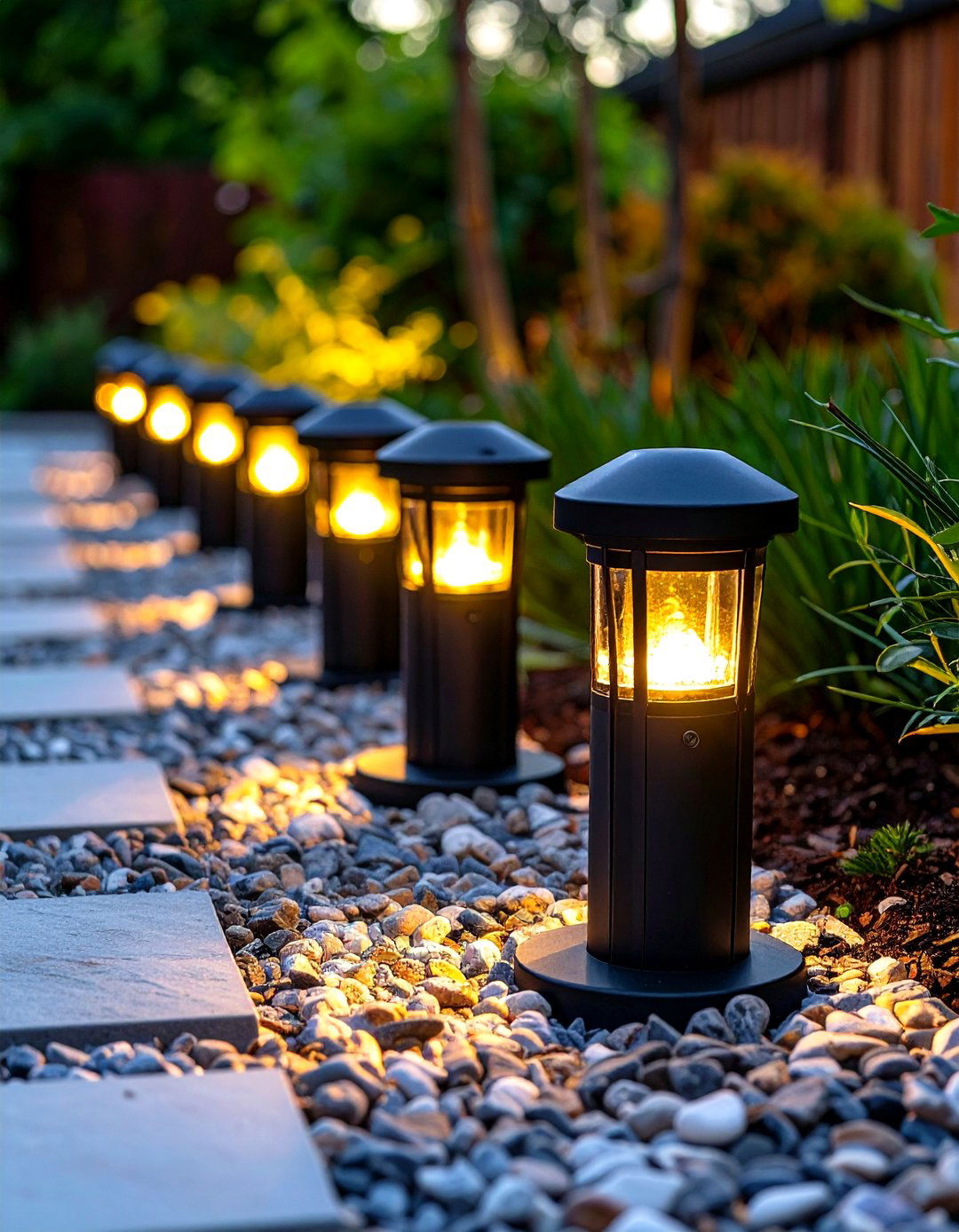
A welcoming path begins with reliable glow, and today’s solar path lights finally deliver both brightness and long runtimes. Modern units use high-efficiency photovoltaic panels, lithium batteries, and LEDs that sip power yet cast a crisp pool onto gravel or pavers. Space fixtures 1–1.5 m apart for an even ribbon, staggering them on opposite sides for visual rhythm. Look for models with 50-plus lumen output and weatherproof housings rated at least IP65 so summer storms or stray sprinklers don’t cut the show short. Choosing warm-white (2700–3000 K) chips blends better with plants than stark daylight hues, creating calm rather than clinical walkways.
2. Tree-Uplighting Garden Lighting Technique

Nothing commands attention like a mature canopy dramatically lit from below. Stake adjustable spotlights 30–45 cm off the trunk, angling beams up through branching architecture to sculpt height and texture in three dimensions. For broad deciduous trees use two narrower 15° beams crossing at mid-canopy; for slender conifers, a single 25–36° wash usually works. LED fixtures between 5–9 W create punch without excess glare and stay cool to protect bark. Remember to reposition annually as branches grow and mulch depths change. Uplighting turns ordinary maples into nighttime monuments while consuming less energy than a single household bulb.
3. String-Light Canopy Garden Lighting
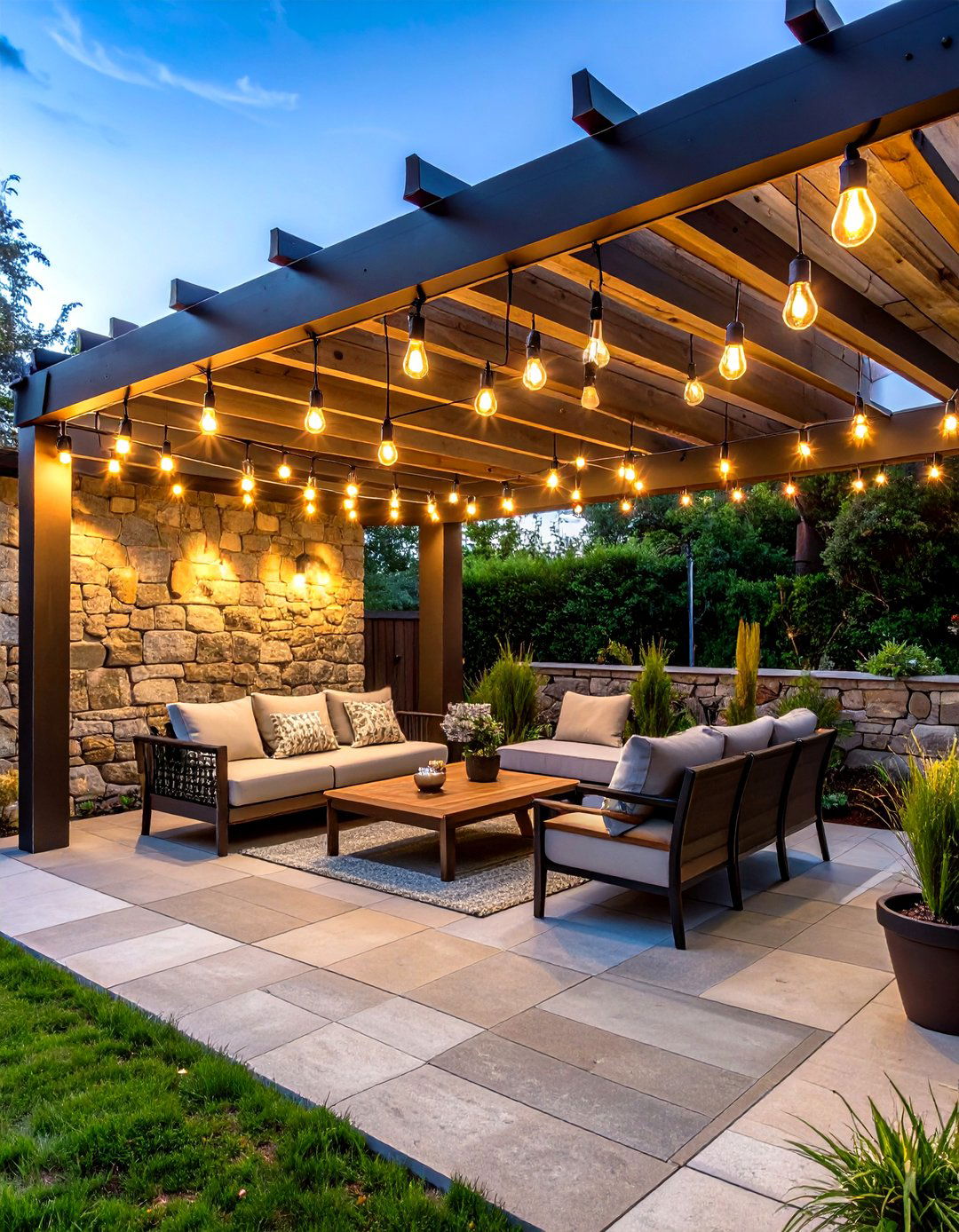
Overhead strings remain the king of casual ambiance, and 2025’s versions marry vintage filaments with low-draw LEDs and rugged weather sealing. Suspend commercial-grade strands on stout wire between eye-bolts or pergola joists so tension, not bulbs, bears the load. Zig-zag patterns shrink large patios into intimate rooms; long parallel runs accentuate narrow courtyards. Aim for roughly 3 m clear height to avoid head bumps and keep beams above sight-lines. Pair dimmable controllers with warm-white Edison-style bulbs for dinner parties, then swap in color sets for birthdays without rewiring the yard.
4. Step-Light Garden Lighting for Safer Stairs

Even shallow risers become hazards after sunset, so integrate low-glare LEDs into every flight. Recessed units mount directly in risers or sit under treads at a 30° downward angle, blanketing each step with soft, shadow-free illumination that preserves depth perception. Solar micro-fixtures simplify remote garden stairs where conduit is tricky, while wired 12 V systems on decks tie neatly into existing railing runs. Choose corrosion-resistant housings—powder-coated aluminum or marine stainless—and match brightness: around 12–20 lumens per step is enough to guide feet without bleaching surrounding foliage.
5. Wall-Washing Garden Lighting to Show Texture
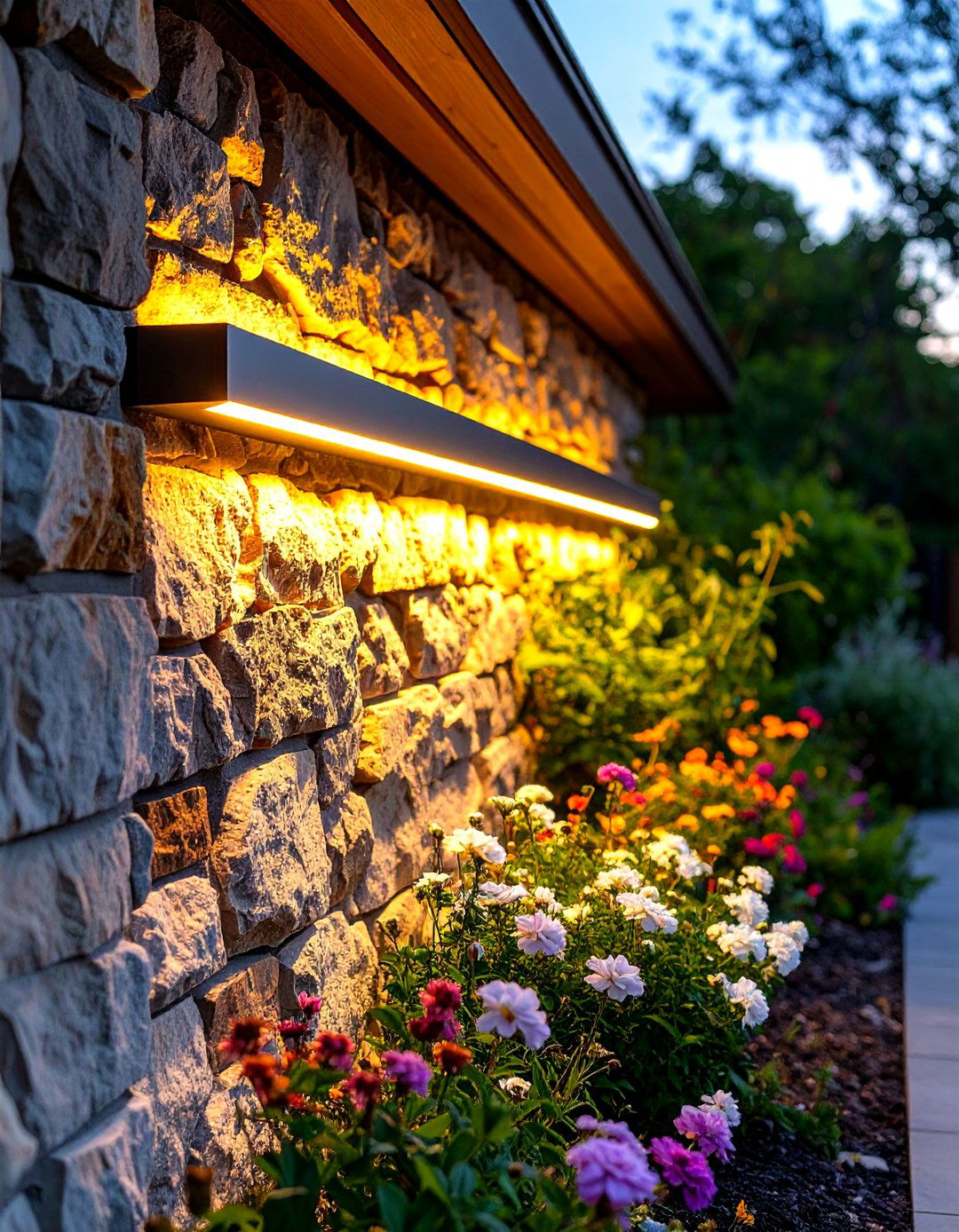
Flat masonry leaps alive when an even sheet of light flows across it. Position linear wall-washer bars or wide-bean floodlights 30–60 cm from a facade, tilting at 10–15° to avoid hot spots. Smooth plaster benefits from broad spacing, while rough stone rewards close grazes that pull every ridge and shadow into relief. Pair with dimmers so bricks glow warmly during dinner yet recede late at night, preserving dark-sky comfort. Wall washing also bounces gentle reflected light onto nearby beds, giving depth without extra fixtures.
6. Smart App-Controlled Garden Lighting
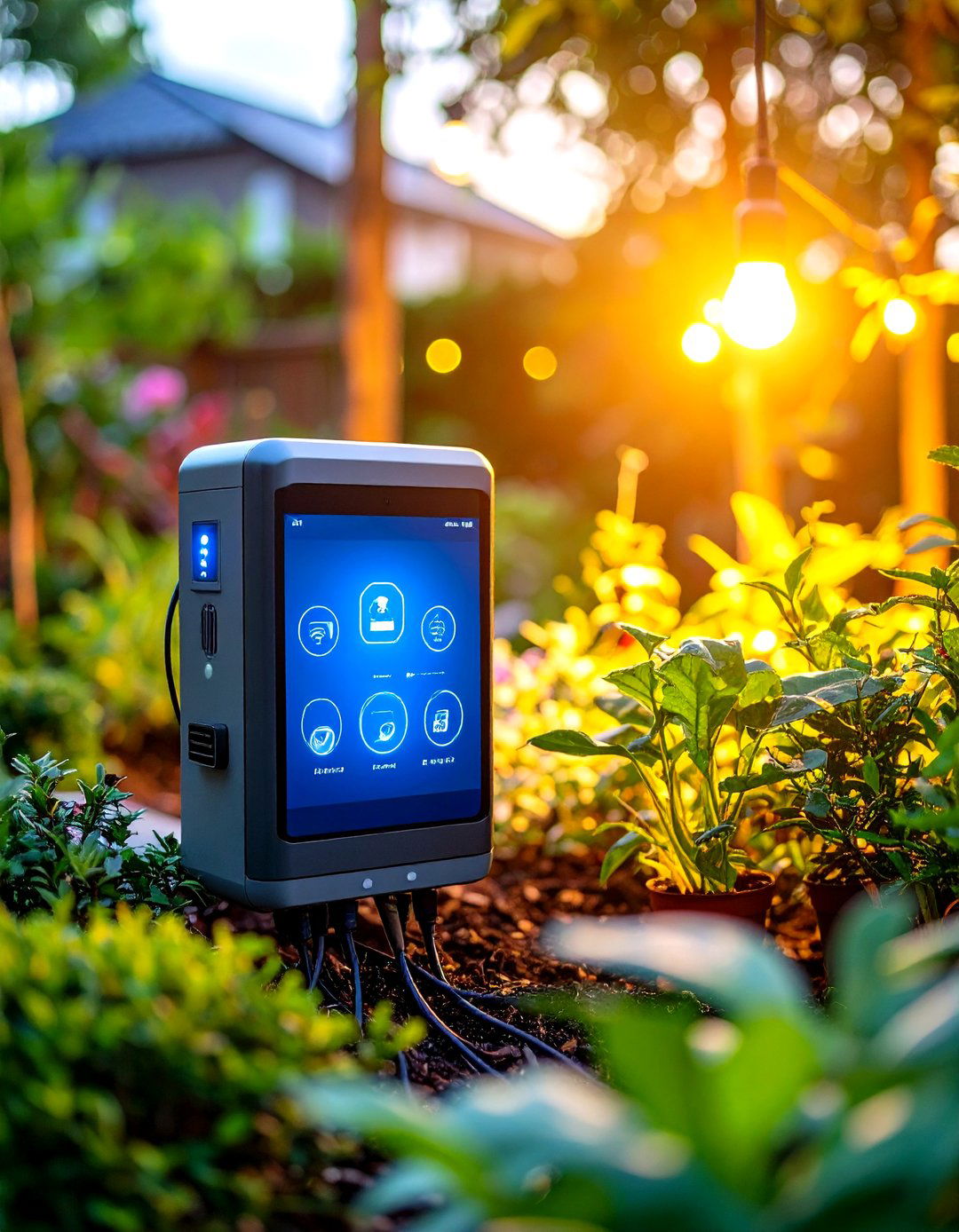
Gone are the days of sprinting across wet lawns to tug a timer. An app-enabled low-voltage transformer lets you schedule zones, fade brightness, or trigger scenes from anywhere. Combine it with Wi-Fi or Bluetooth fixtures to tweak hues for seasonal moods—warm amber in autumn, icy blue in midsummer heat. Voice integrations tie lights to weather alerts or motion sensors, boosting security with zero extra wiring. Opt for systems offering over-the-air firmware updates so features expand over time instead of dating quickly.
7. Motion-Sensor Security Garden Lighting
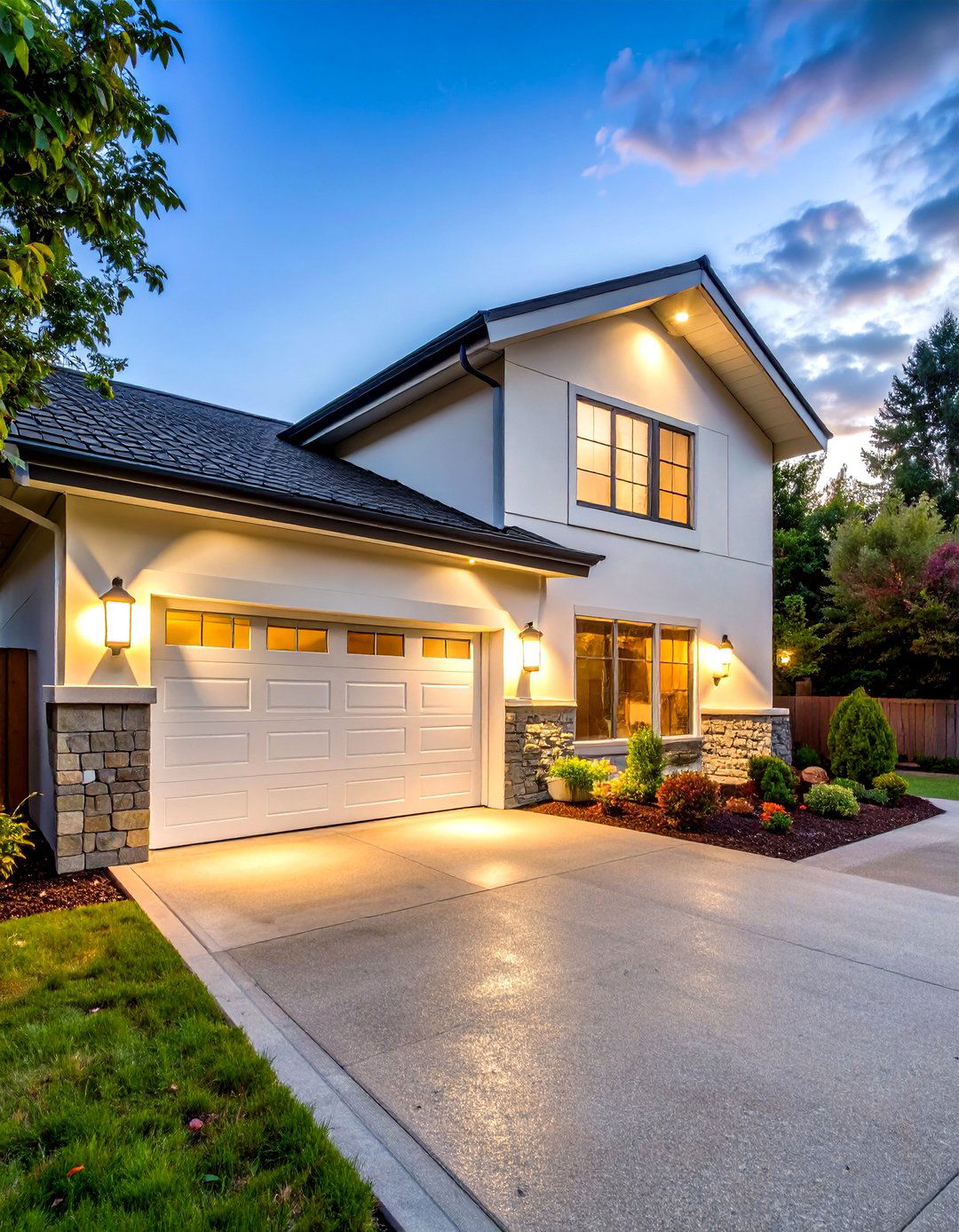
Strategically placed PIR-activated floods deter intruders and spare electricity. Mount units 2.4–3 m high beside garage corners or rear gates, aiming beams downward at 30–45° to minimize glare into neighbors’ windows. Choose models that blend a focused spot (900–1500 lumens) with a dim ambient mode when idle, preventing dark vacuums that reset pupils. Dual-head designs cover wide angles; look for adjustable shut-off delays and daylight sensitivity so lights rest in sunshine. Integrated LEDs outlast halogen floods, slashing maintenance runs up ladders.
8. RGB Color-Changing Garden Lighting
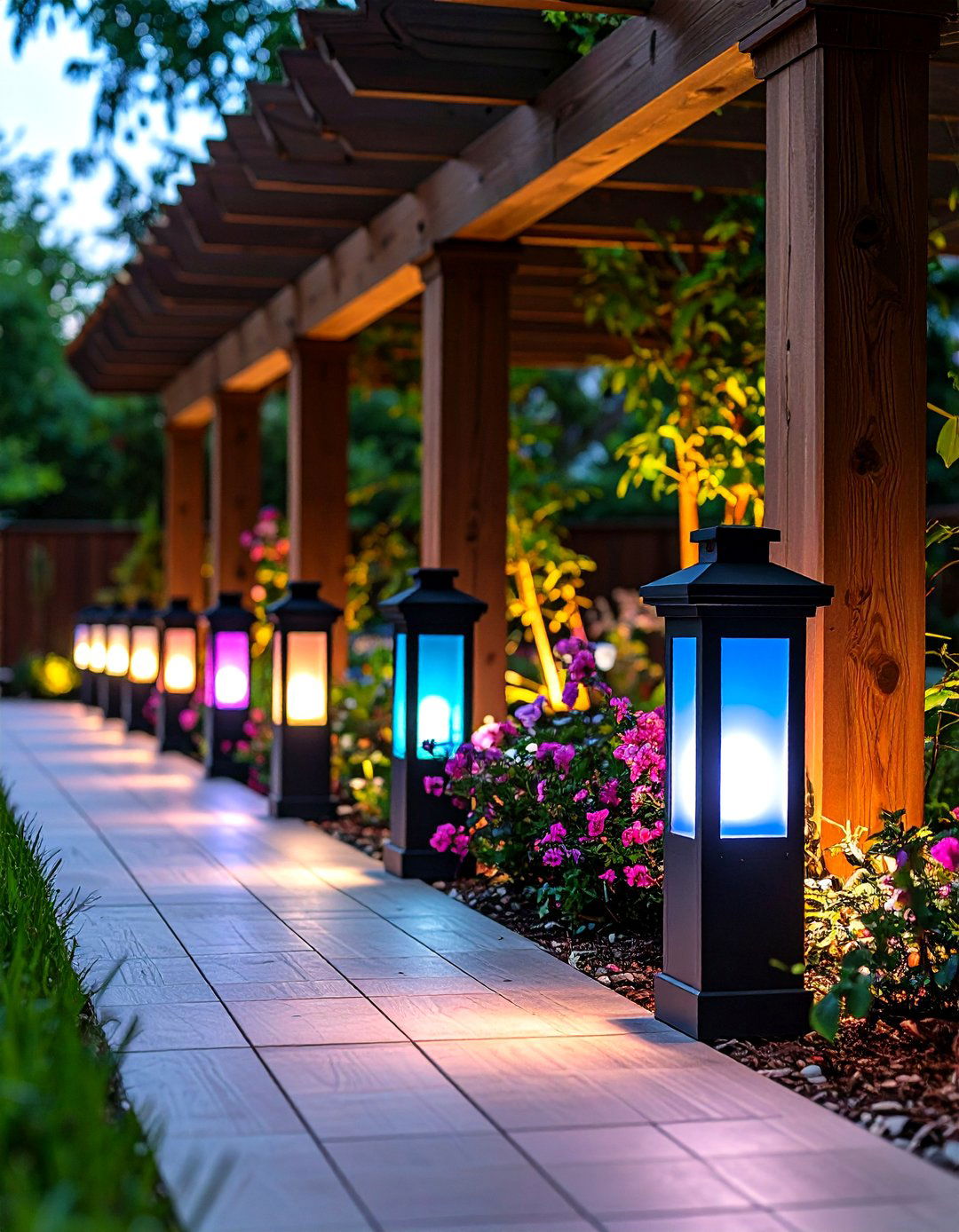
Color-tunable spotlights and strip kits unlock theatrical flexibility—think soft blush for Valentine’s dinner or azure for pool parties. Modern RGBW LEDs retain a dedicated warm-white diode so ordinary evenings still feel natural. Remote or app control cycles through programs, dims individual channels, and stores presets. Keep saturated tones on focal points only; drenching the whole yard in neon can flatten depth. When accenting foliage, choose greens a shade cooler than the leaves so contours pop rather than disappear.
9. Moonlighting Garden Lighting from the Trees
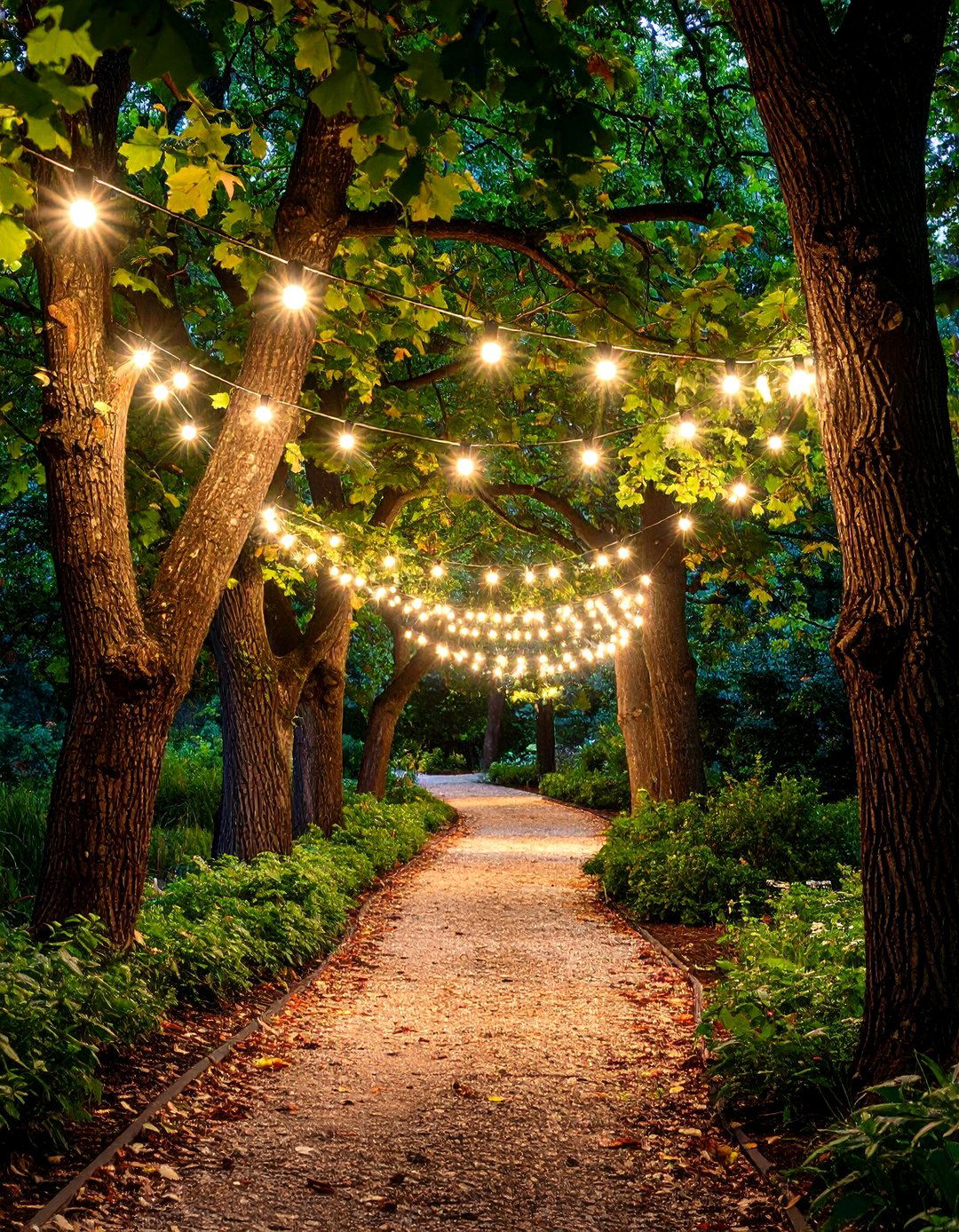
Recreate romantic full-moon glow by mounting downlights 6–9 m high in mature trunks or roof eaves, aiming through branches so leaves cast dappled shadows on paths. Cool-white LEDs (4000 K) mimic lunar tint, while glare shields hide the source, maintaining mystery. Use rugged fixtures with tree-friendly stainless banding—never screw directly into living bark. Cable slack in gentle loops to allow growth. Moonlighting softly unifies large spaces without the harsh glare of pole-mounted floods, making gatherings feel like forest clearings.
10. Recessed Deck-Light Garden Lighting

Flush-mounted LEDs set into decking boards or within railing posts extend alfresco living late into the night while protecting sight lines toward the horizon. Position units 10–15 cm in from board edges to prevent glare and choose IP67 housings that shrug off rain, spilled cocktails, and pressure-washer sessions. Many kits plug-and-play via daisy-chain connectors, letting you add more as entertaining zones grow. Match color temperature to overhead string lights for cohesive ambiance and link to smart transformers for zoned dimming during stargazing sessions.
11. Lantern Cluster Garden Lighting Centerpieces

Nothing beats the gather-round charm of candle lanterns grouped on a patio table or porch step. Mix heights—tall hurricanes with squat box lanterns—to layer glows and reflections. Swap real candles for rechargeable LED pillars with flicker modes, eliminating wax drips during summer heatwaves. For casual nights, scatter single lanterns along retaining walls; for celebrations, cluster five or more as an instant focal sculpture. Choose powder-coated steel or teak frames that weather gracefully, and store spare batteries in the base so lights never fizzle mid-meal.
12. Submersible Pond-Light Garden Lighting
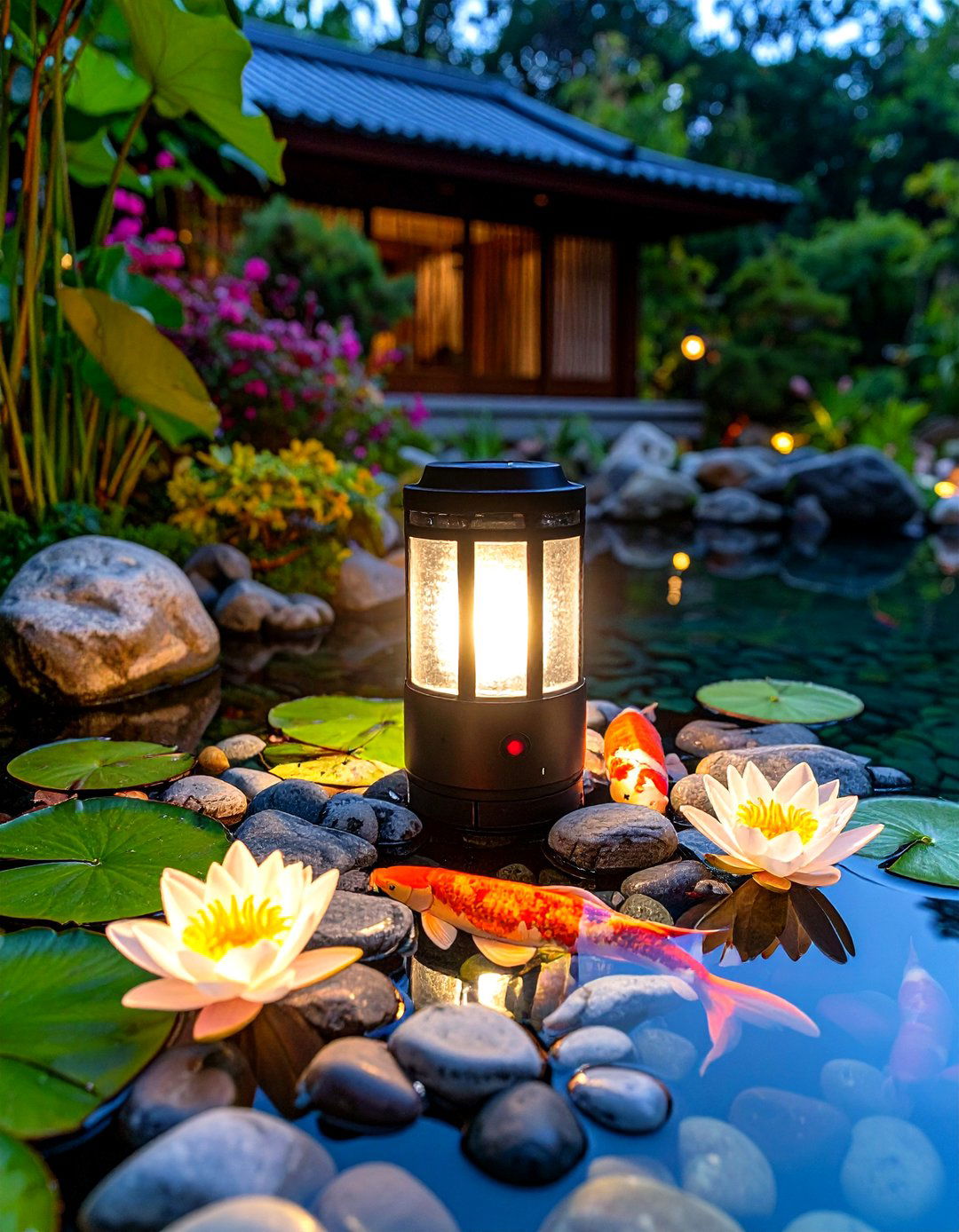
Water doubles the magic by reflecting every beam, so drop IP68-rated fixtures at 15–30 cm depth, angling slightly upward to avoid surface glare. Cool-white spots accent koi fins, while color-cycling puck lights transform fountains into liquid fireworks. Use weighted bases or adjustable brackets to reposition as lily pads shift through seasons. Route cables in flexible conduit under edging stones to hide runs and prevent fish tangles. A twilight sensor can switch pond lights independently, ensuring ripples shimmer even when path lights remain off for dark-sky compliance.
13. Low-Voltage Transformer Garden Lighting for Efficiency
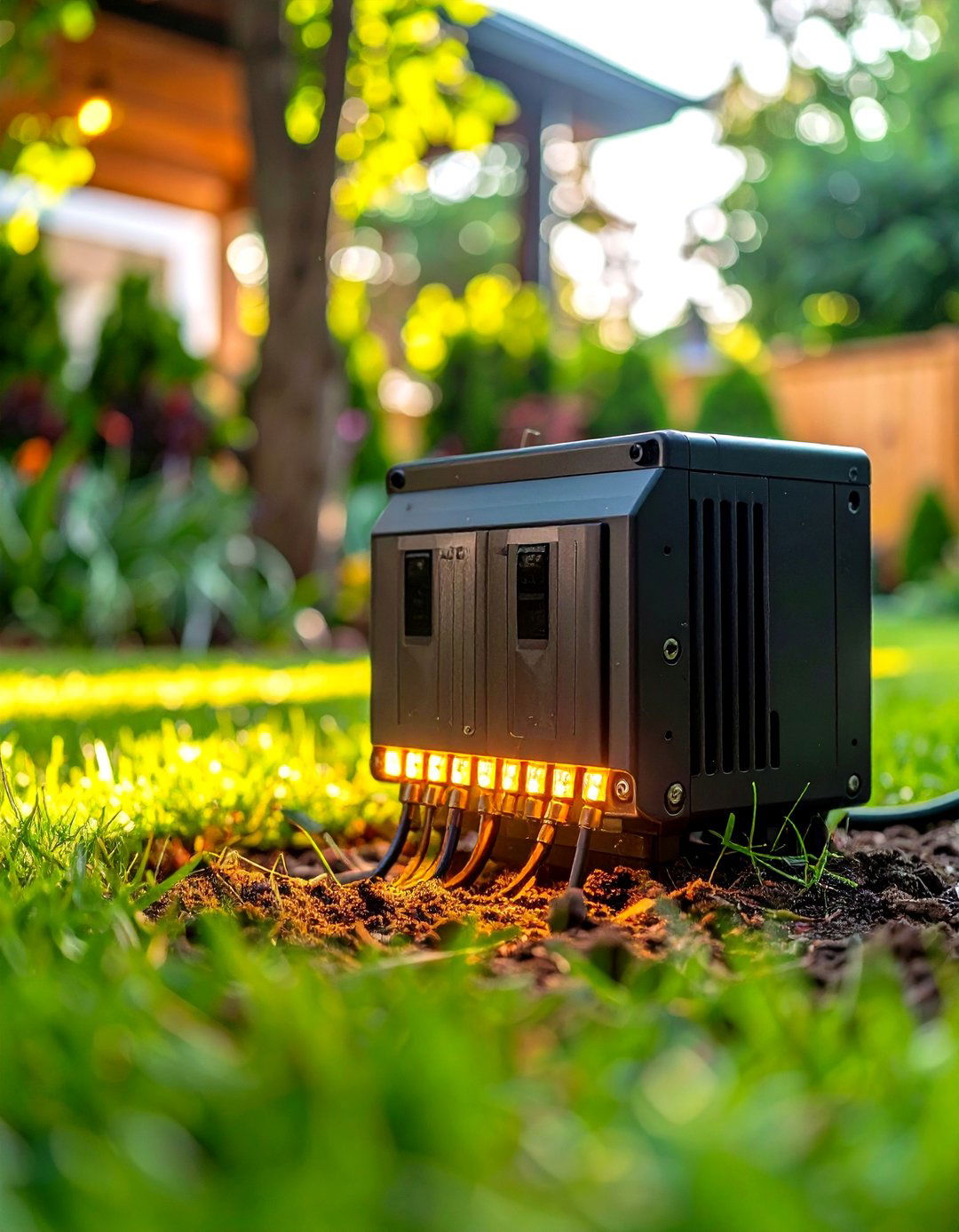
Running 12- or 24-volt circuits dramatically improves safety and simplifies DIY installation. Place the transformer within 30 m of the furthest fixture to curb voltage drop, choosing one with at least 20 % spare wattage for future expansion. Many smart units auto-sense LED loads, eliminating manual tap adjustments. Use UV-resistant, direct-bury cable 30 cm deep under lawns or tuck behind edging in beds for tool-free maintenance. Remember that lower voltage means thicker gauge on long runs—consult load charts to keep brightness consistent end-to-end.
14. Fairy-Light Garden Lighting in Shrubs and Topiaries
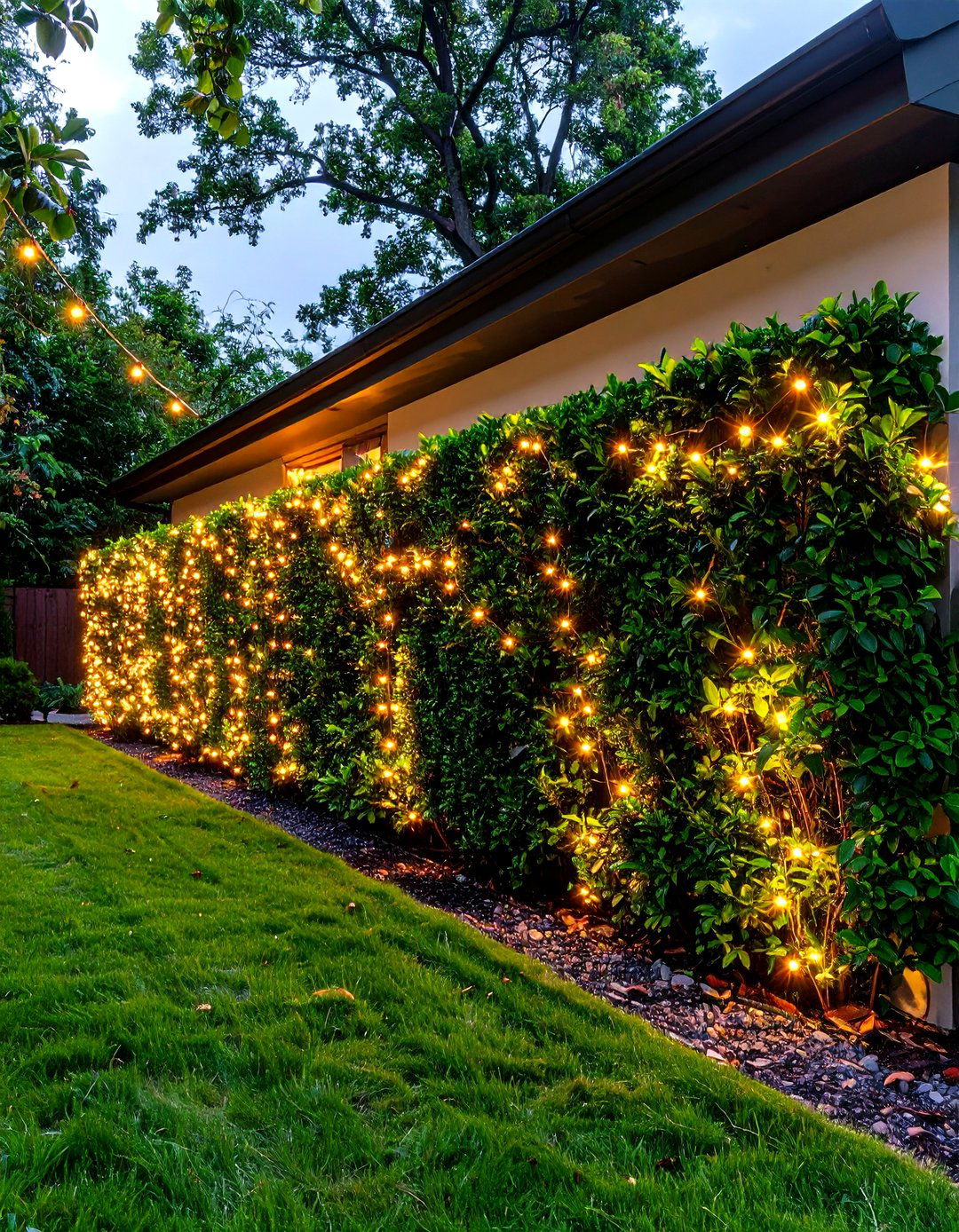
Weaving micro LEDs through shrubs turns greenery into living constellations. Net-light sheets drape over box hedges in minutes, but wrapping individual branches with copper-wire strands yields more organic sparkle. Battery or solar packs hide inside foliage; choose models with six-hour timers so lights blink on at twilight then fade automatically. Cool weatherproof coatings resist sap and sprinkler overspray. Reserve warm-white for relaxed hosting and gentle 2200 K amber during moth-heavy months to reduce insect attraction.
15. Bollard-Light Garden Lighting for Driveways
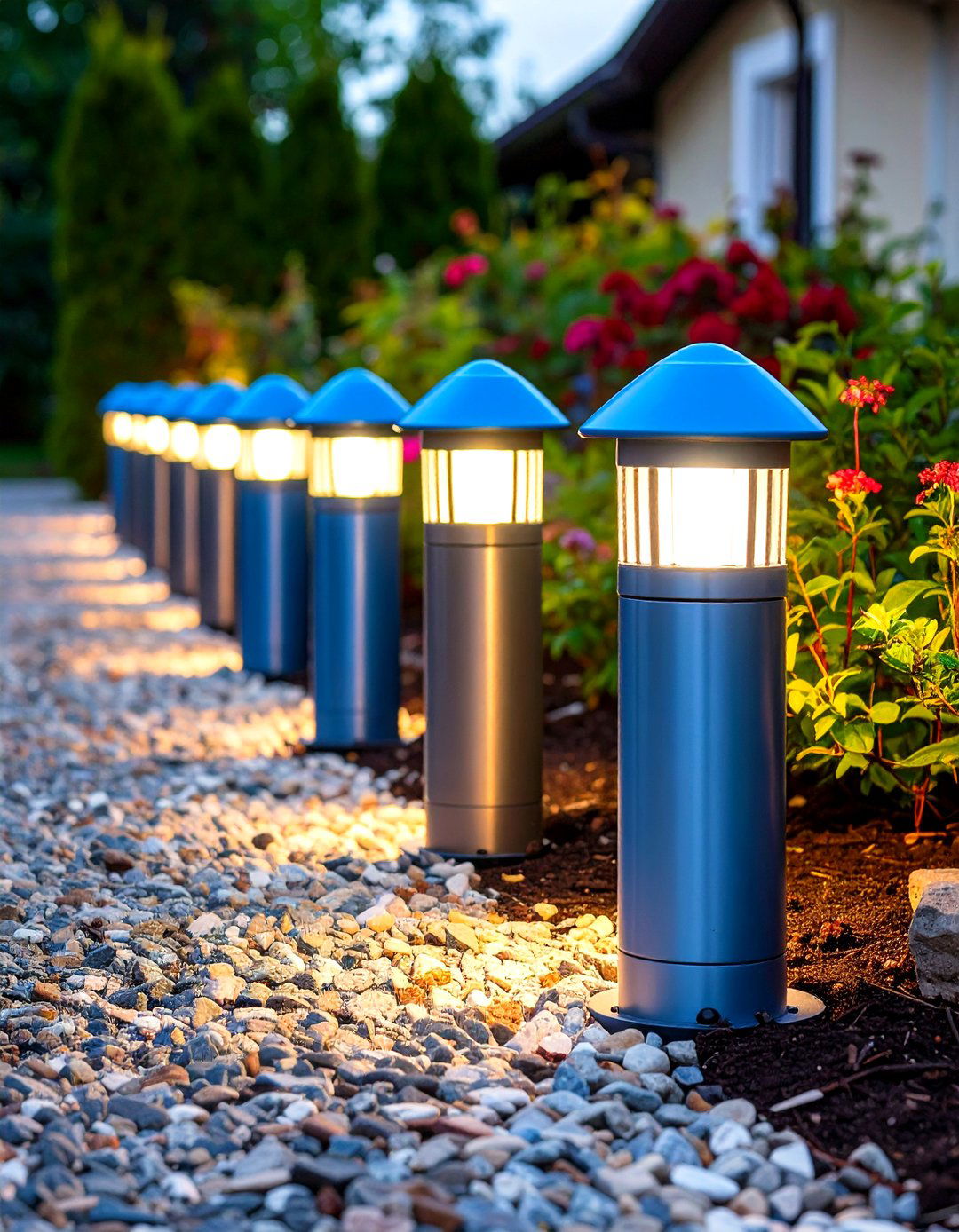
Sturdy bollards provide sculptural markers and practical pool-of-light guidance along driveways or wide paths. Space units roughly equal to their mounting height—1-1.5 m—so glows overlap without streak gaps. Dark-sky compliant hoods direct beams downward, preserving star views and neighbor relations. Select vandal-resistant powder-coated aluminum for public-facing edges or playful mushroom-shaped solar stakes in cottage gardens. Integrated LEDs last upwards of 50 000 hours, meaning maintenance ladders stay in the shed for years.
16. Sculptural Feature Garden Lighting
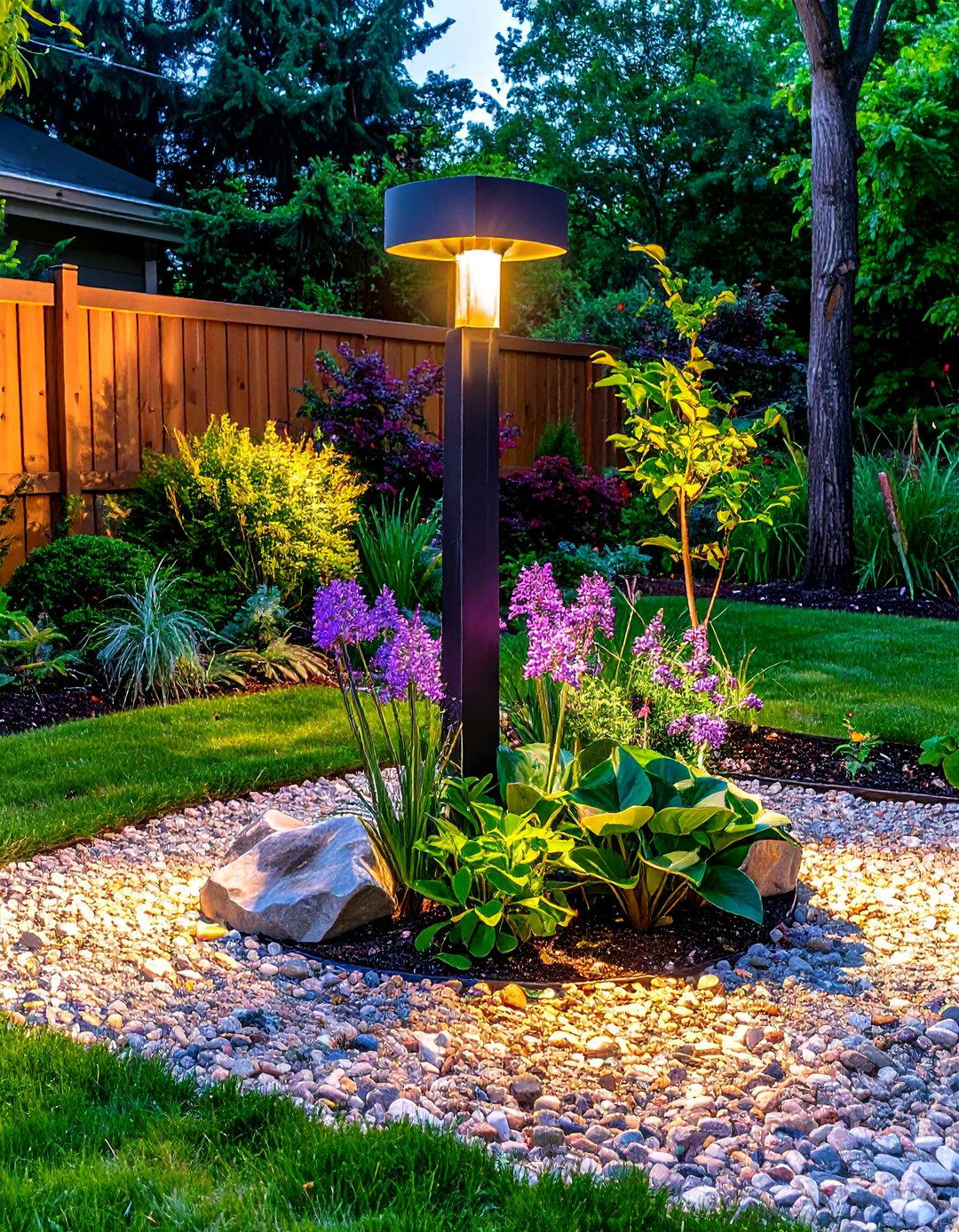
Turn artwork into a beacon by pairing it with focused accent lights. Offset fixtures 50–100 cm so beams skim across contours, creating depth and drama. Combine uplights and subtle downlights to reveal both silhouette and texture without flattening detail. For mirrored or metallic pieces, lower lumen output prevents blinding kicks of glare; for matte stone, stronger 7–10 W spots punch distance. Consider color-changing LEDs for contemporary sculptures so hues shift with exhibitions or seasons.
17. LED-Strip Garden Lighting Under Railings
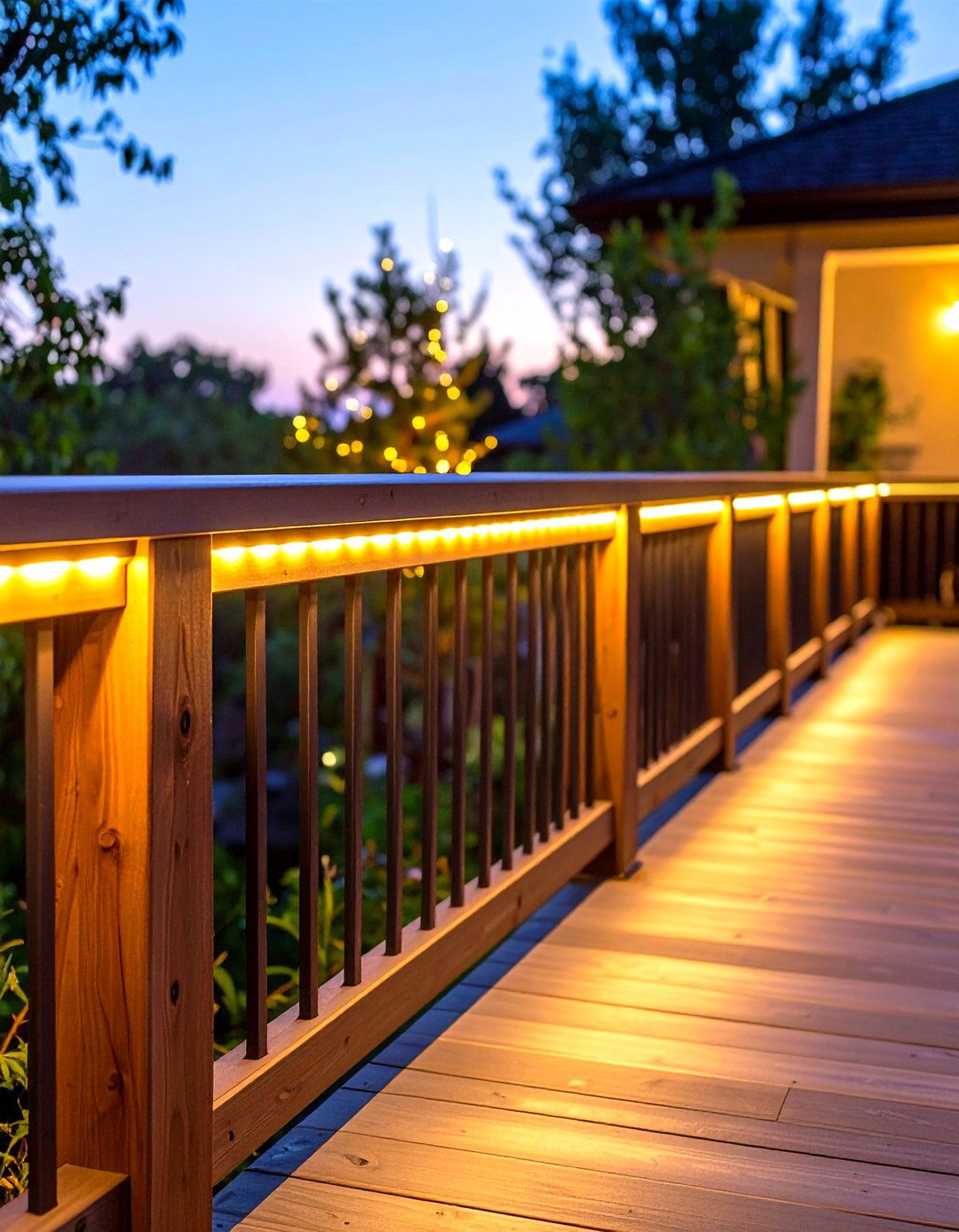
Low-profile strips tuck under seat benches, handrails, or planter lips, providing diffuse glow that feels like hidden magic. Choose outdoor-rated IP65 silicone-encased tapes and aluminum channels to shed heat. At steps, strips act as visual cues without the point glare of individual diodes, perfect for minimalist design schemes. Cut every 5 cm section to length and join via waterproof connectors; power multiple runs from a central driver tucked beneath decking. Pair with motion sensors so rails illuminate only when someone approaches, stretching both battery life and wow factor.
18. LED Tea-Light Garden Lighting in Planters
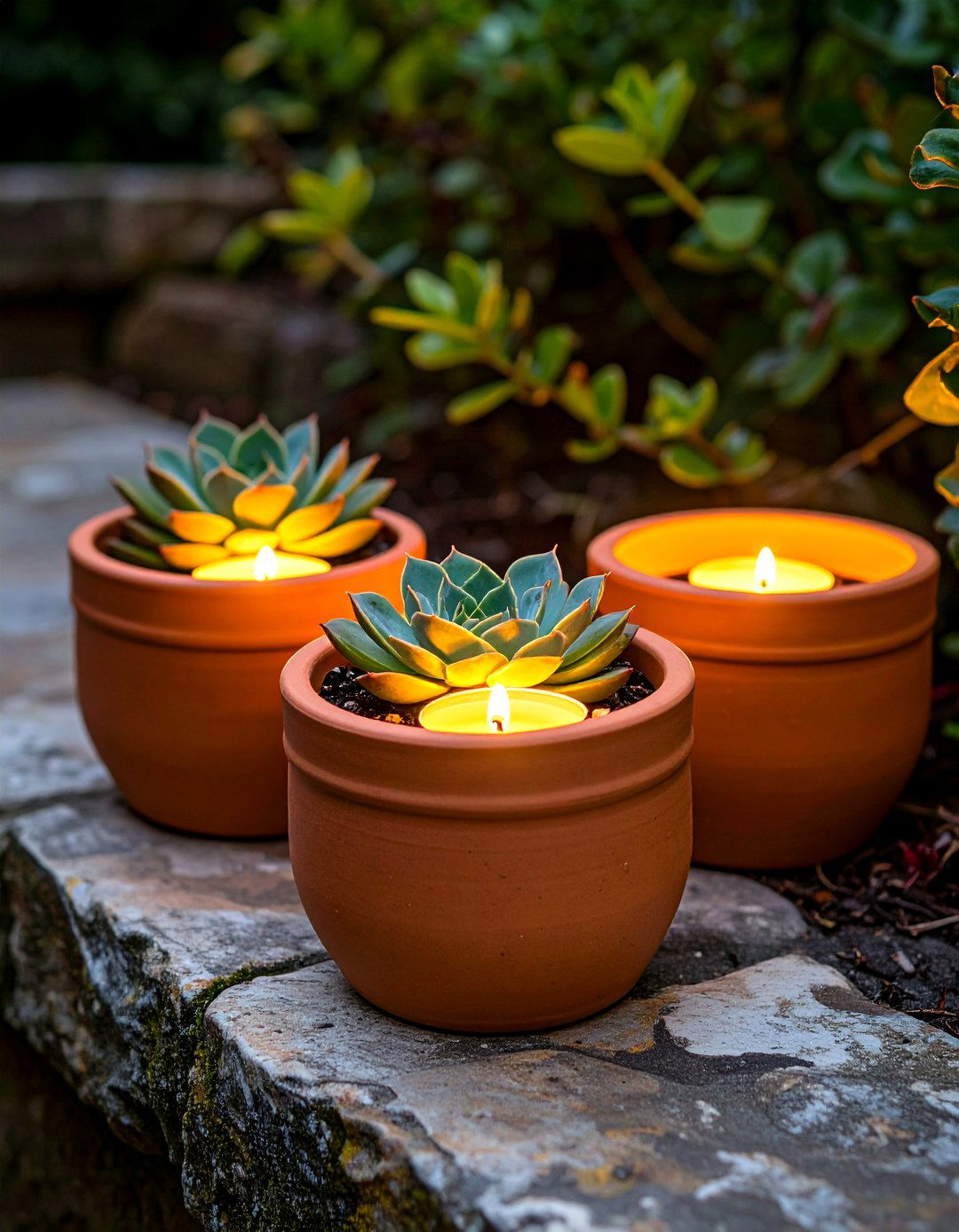
Small planters double as lanterns when you nest flameless tea lights among succulents or herb pots. Opt for versions with eight-hour rechargeable cells and remote timers, sparing nightly resets. Clear glass pebbles amplify brightness, while colored mulch masks plastic housings. Cluster three to five pots on stair landings or window ledges for inviting depth that still reads intimate. Swapping pillars into tall hurricane sleeves lets you upscale the look for formal dinners without purchasing new gear.
19. Water-Feature Mirroring Garden Lighting

Position lights just outside a fountain or reflective pond, aiming beams toward adjacent plants rather than the water itself; the mirror does the rest. A single 5 W spotlight can appear as two when reflected, instantly doubling visual impact without extra energy. Combine gentle ripples with cool-white LEDs for shimmering highlights or color-tunable fixtures for koi-pond theatrics. Always keep cables on the dry bank in protective conduit and use GFCI protection to safeguard swimmers, pets, and pumps.
20. Programmable Scene Garden Lighting for Seasons
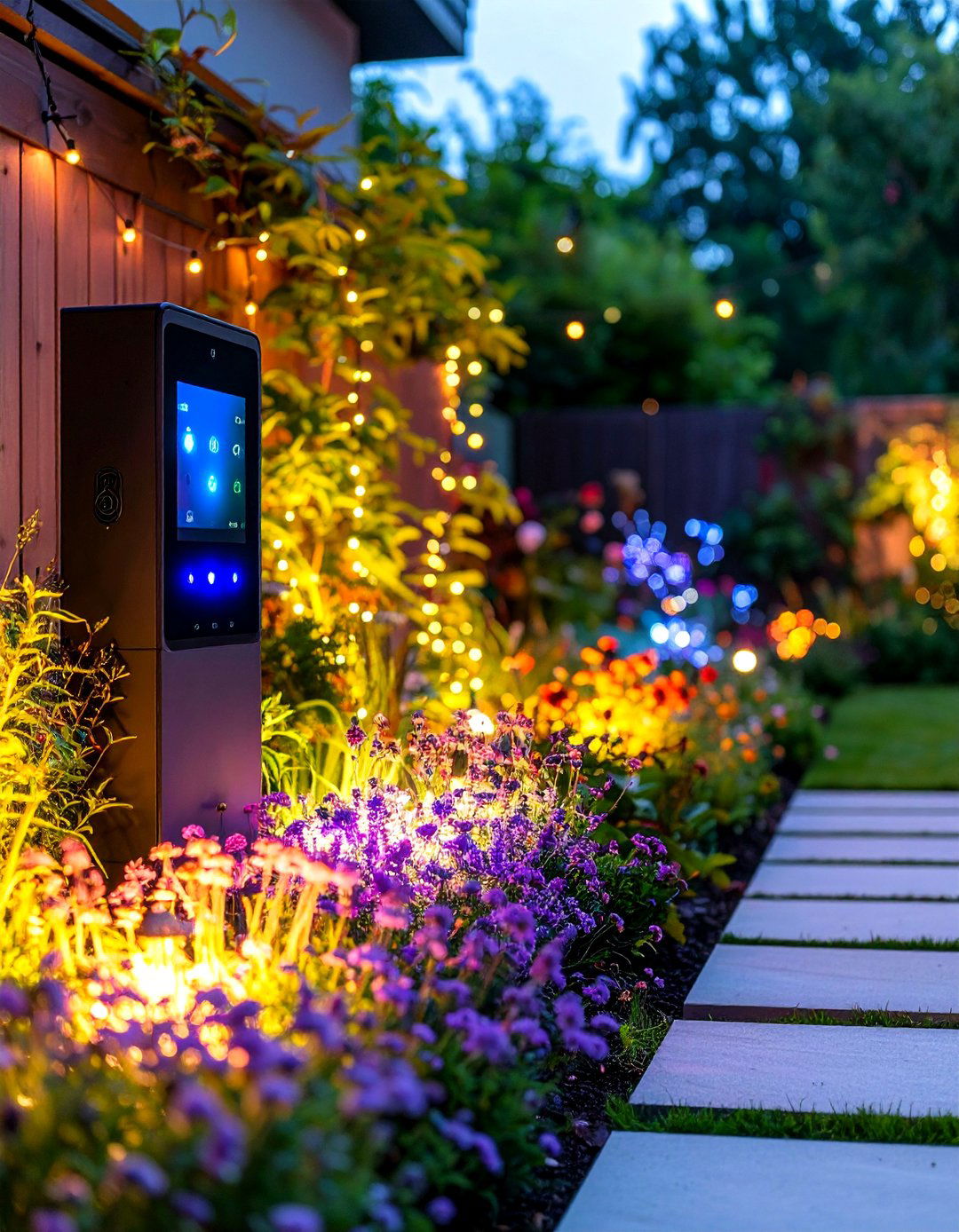
Finish your masterpiece with a smart hub that stores themed scenes—think pastel hues for spring blooms, patriotic flashes on national days, or calming warm dim for yoga at sunset. Controller apps group fixtures by zone, coordinating fairy lights, spotlights, and path markers with one tap. Adaptive scheduling adjusts on/off times weekly to track changing sunset, while solar/rain sensors override when daylight stubbornly lingers. Firmware-upgradable systems protect your investment, adding future animations without swapping hardware.
Conclusion:
Thoughtful garden lighting is less about flooding every corner with lumens and more about layering effects that celebrate structure, guide movement, and set moods. By combining energy-savvy technology—solar panels, LEDs, smart transformers—with classic artistry such as moonlit trees or candlelit tables, you create an outdoor retreat that feels safe, looks spectacular, and invites year-round enjoyment. Start small with one of the ideas above, observe how shadows transform your favorite plants or paths, then expand in responsive layers; your garden will reward every carefully placed beam with beauty long after the sun goes down.


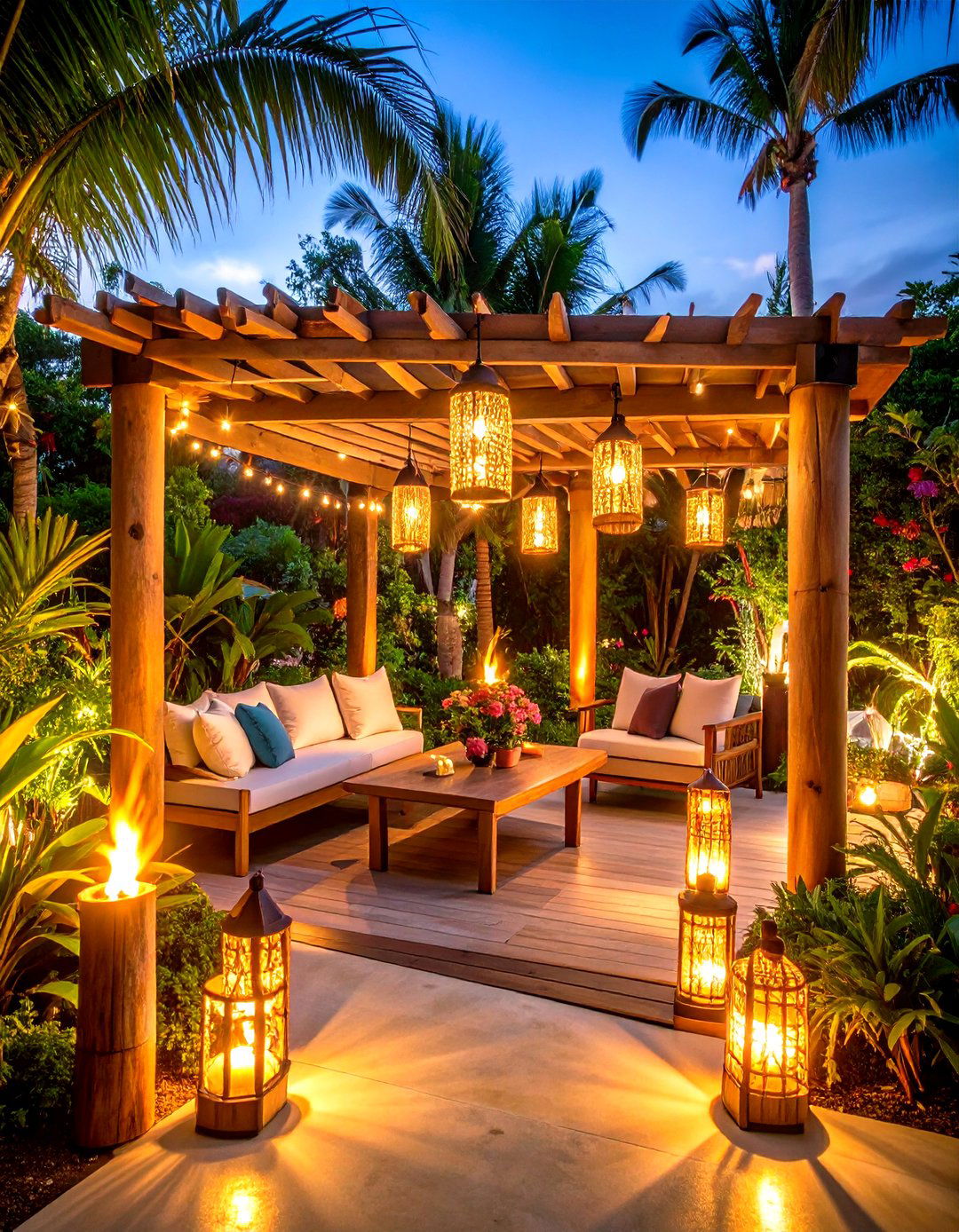

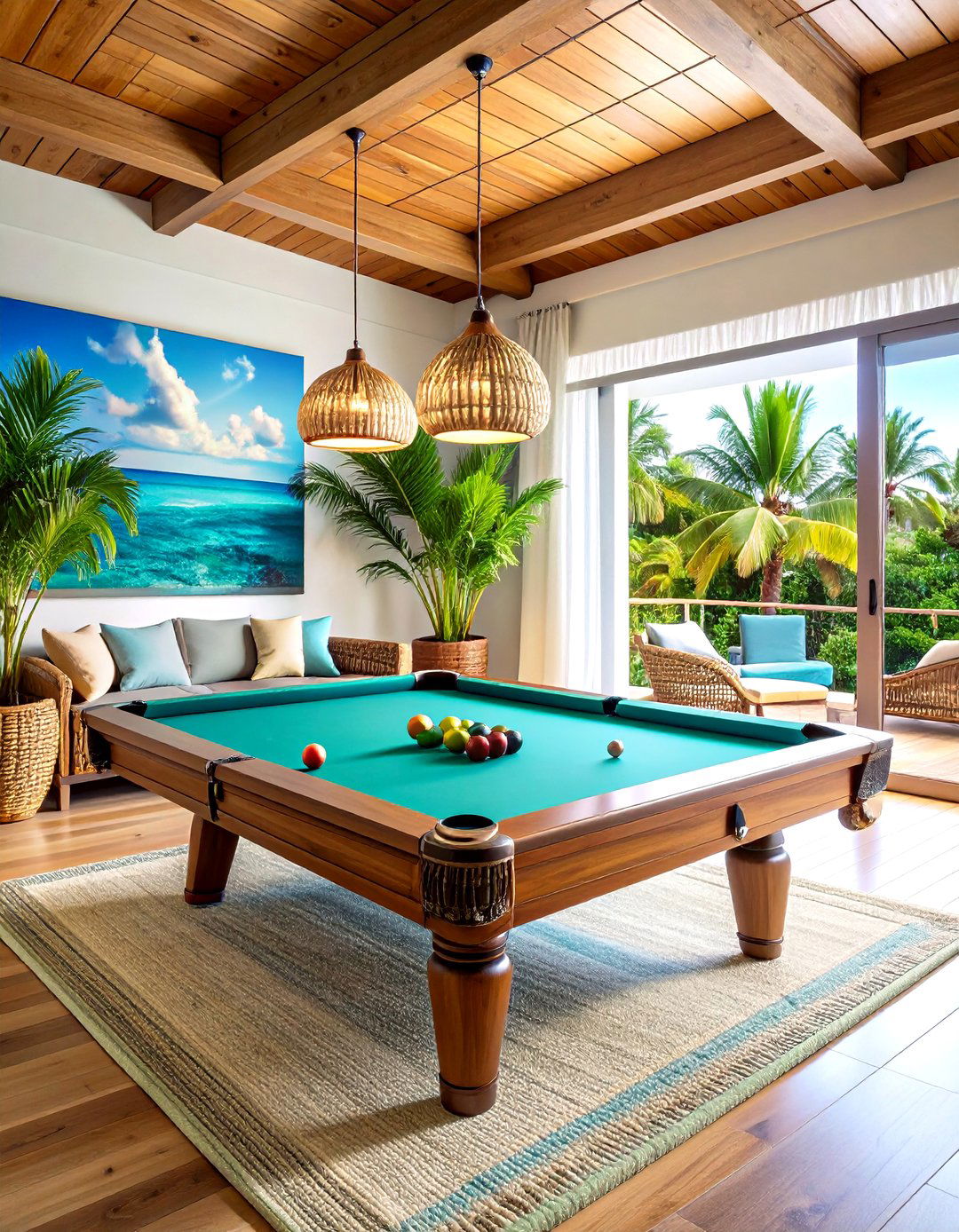
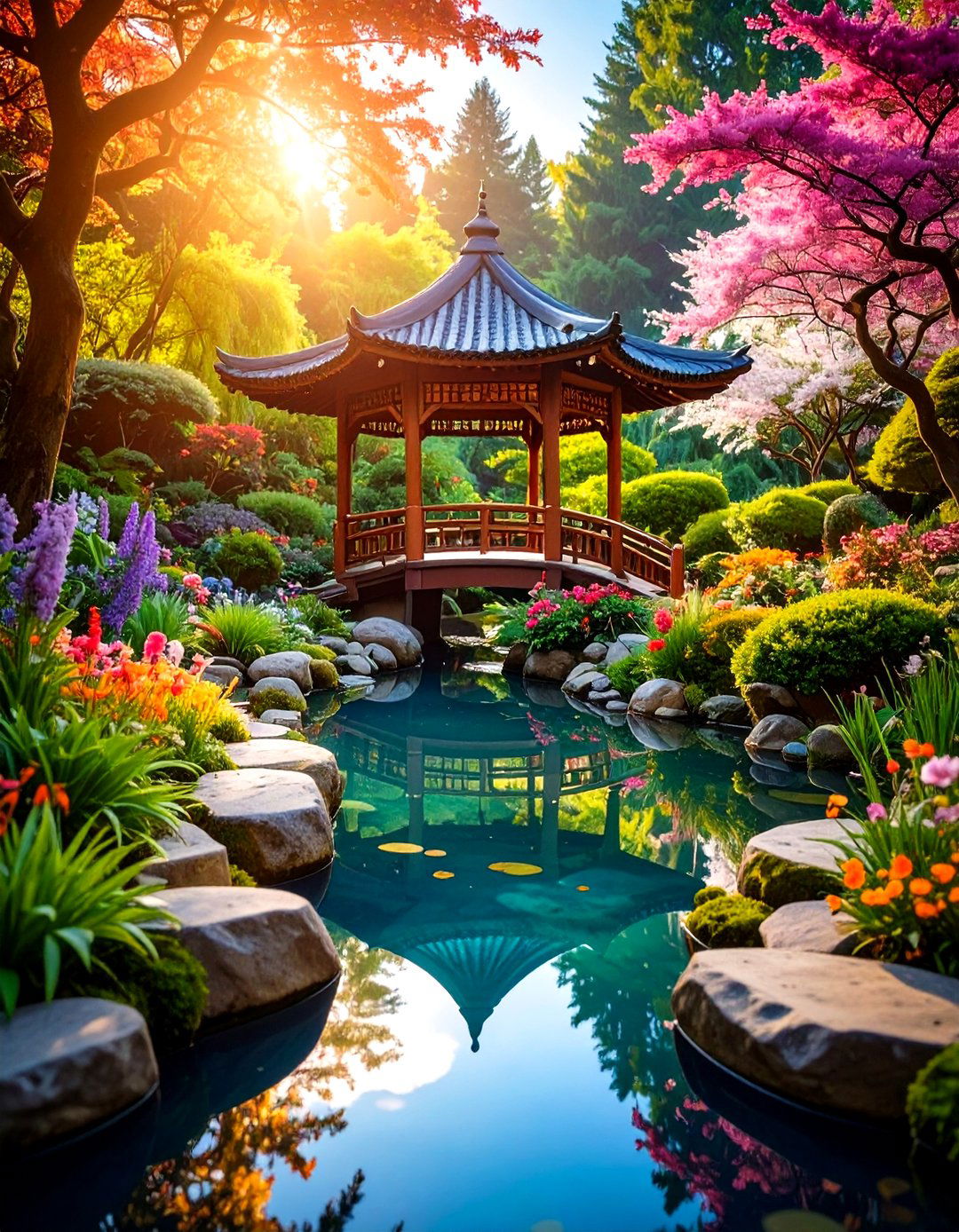
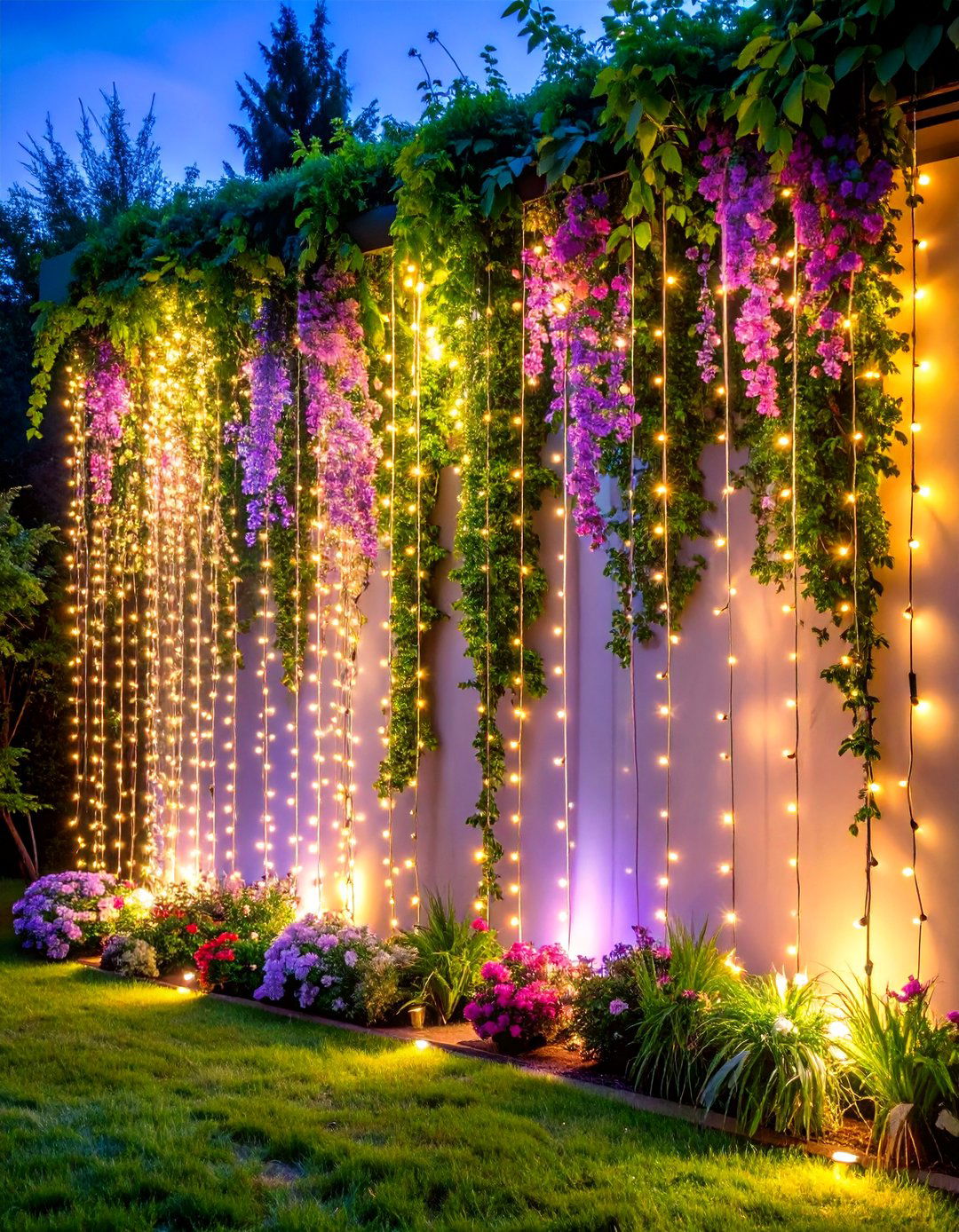







Leave a Reply